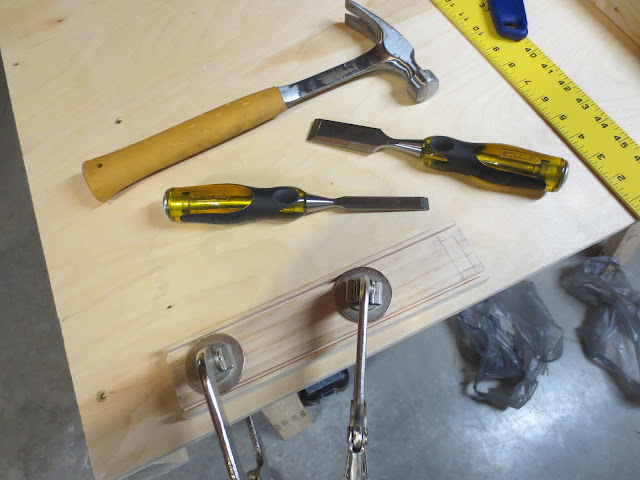Hello again!
I've made good progress on my project over the past few days; time for an update. When I left off I had glued and clamped the last of the pieces for the first "bee cartridge." In this episode I've finished construction of the cartridge and also started construction of the first "bee airlock" which will allow bees to travel from one cartridge to other cartridges without getting loose in the house.
For starters, here's a picture of the assembled cartridge after the glue finished drying.
To make sure the cartridge was build correctly and my measurements were sound, I test-fit a Langstroth frame into the cartridge. This frame will hold a sheet of beeswax, on which the bees will "draw comb" to build their hive. I've built a 5/16 inch bee space on all sides of the frame so the bees can navigate their home.
Next, I cut the first plexiglass window and tested to make sure it fits. The plexiglass slides smoothly into the 1/8 inch slots I cut and fits flush on all sides. The bees will do the rest of the work - when they make themselves at home they'll glue the windows in place, or "propolize" them.
Because I've decided to vent the cartridges, the vent holes must be meshed over. To this end, I've cut and stapled a narrow-gauge aluminum mesh to the handle side of the cartridge. I may secure the mesh further with a bead of wood glue, but for now it appears to be sufficiently well attached.
Finally, I attached the handle to the cartridge. One cartridge done, 11 more to go!
The next step in my project is to start building the frame which will hold the cartridges. Since this project is going to be fairly large, during the design phase I quickly identified I would need to build it as modules which can be put together as I go. With this in mind, the next part I decided to build is the "bee airlock" which I'll call a "beelock" from now on. The beelock's main function is to provide a path for the bees to travel between two frames, and its secondary function is to allow me to close off a section of the hive so I can remove a bee cartridge for maintenance or inspection. Finally, I wanted to be able to see the bees as they move from one part of the hive to another, so I decided to incorporate plexiglass windows into the beelock.
As always, I designed the beelock in Sketchup before I started cutting wood. You might notice in all my designs there's no plexiglass included - I find it's easier to just plan the slots where the plexiglass will fit without going through the trouble of drawing it in the design.
The first step of building a beelock is to cut long pieces which will hold the plexiglass windows.
Since these pieces will hold plexiglass on two of their surfaces, I next cut 1/8 inch slots with my table saw.
Next up, end pieces.
Since plexiglass will be joined with these pieces, I slotted them on their interior edge to match up with the top and bottom pieces.
Then I cut and mounted the first piece of plexiglass to see how the pieces will fit together. Everything is fitting together almost as perfectly as Legos!
Next, a mockup with both pieces of plexiglass and both endcaps installed before I start gluing.
On to gluing - the first encap is the most difficult to glue because there's nothing holding the pieces in the correct position but your clamp. To help make sure the proper spacing is maintained I again used 5/16 inch spacers to keep things aligned.
Next I glued the top pieces to the endcap. Again I used spacers, and the plexiglass pieces already installed helped keep the beelock further aligned.
At the midpoint I decided to shore up the design so there wouldn't be too much pressure on the plexiglass, so I cut some bracing spacers.
Then I glued and clamped the spacers in place.
There will also be bracing spacers in the horizontal slot - these spacers will provide reinforcement and also prevent bees from escaping when they move horizontally through the beelock.
Horizontal spacers installed, glued, and clamped.
I had to wait for the spacers to dry before I could continue on to the last endcap, so the completed beelock will be featured in the next episode. I will also be building the base of the hive in the next episode, including fitting the hose assembly the bees will use to venture outdoors.
Thanks for looking!




























































